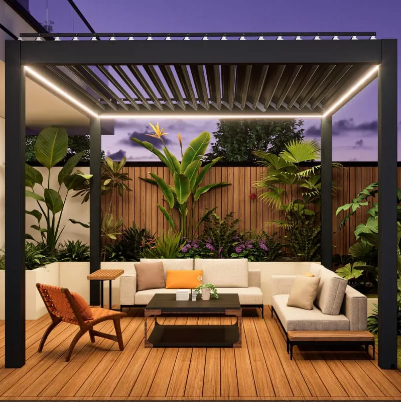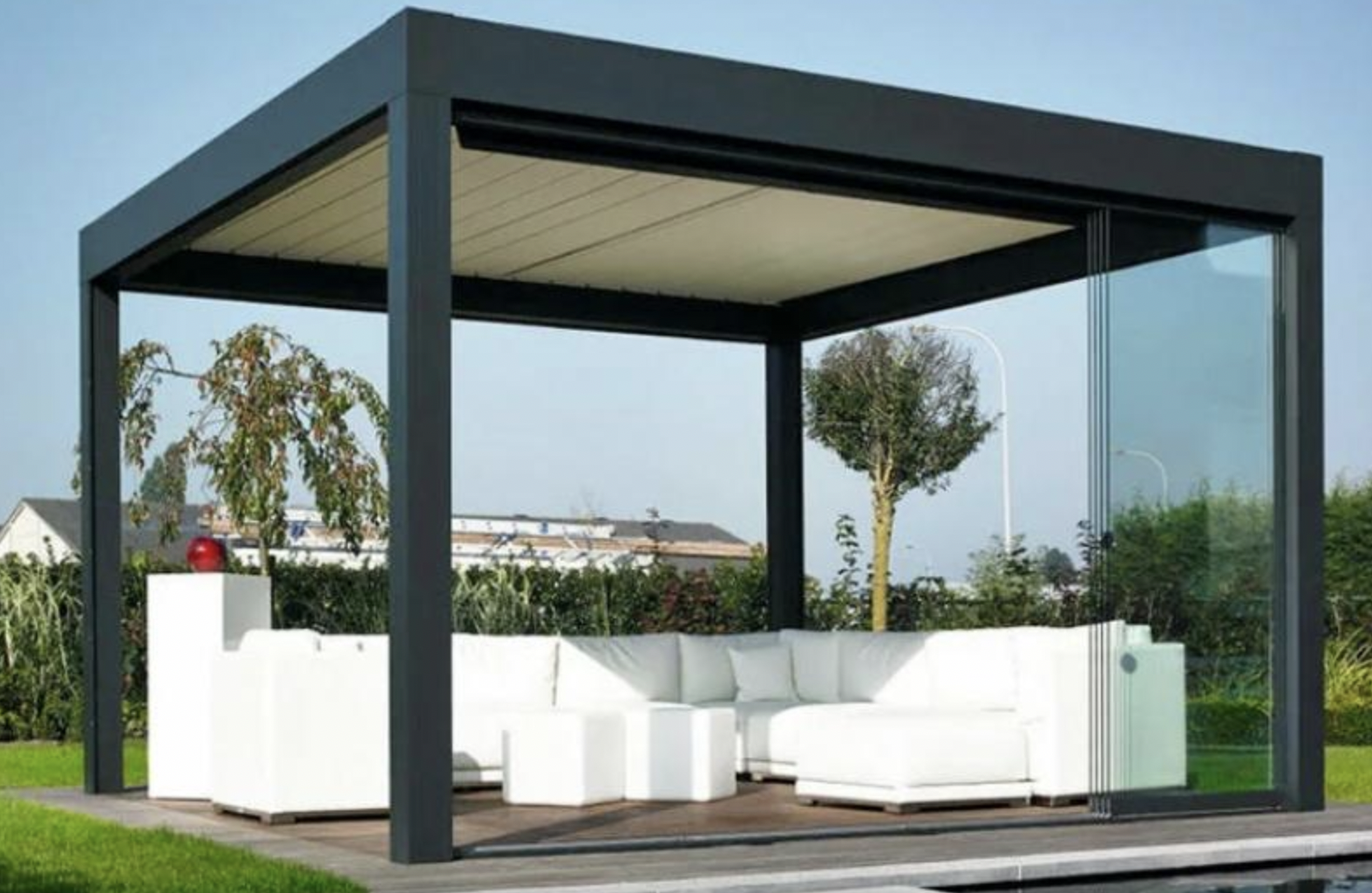تحديد البلكونة السقفية الحديثة الحرة
من هياكل الظل القديمة إلى التصميمات المعاصرة
يحب الناس في الوقت الحالي وضع pergolas قابلة للتركيب في فناء منازجهم، لكنها تطورت بشكل كبير منذ تلك الهياكل البسيطة التي استخدمها المصريون واليونانيون القدماء قبل آلاف السنين. الإصدارات الحديثة تبدو جذابة وتعمل بشكل فعال أيضًا، وهو ما لم تكن الإصدارات القديمة قادرة على تحقيقه. خذ على سبيل المثال تلك الألواح الخشبية التقليدية التي استُبدلت بإطارات من الألومنيوم لامعة تحتوي على شرائح قابلة للتعديل تسمح بمرور أشعة الشمس بالطريقة التي نريدها، كما تحتوي العديد منها على إضاءة مدمجة مناسبة للحفلات المسائية. كما ساهمت الثقافات المختلفة في تشكيل هذه الصيحة على مر الزمن. فـ pergolas ذات الطراز المقوس الفاخر من حقبة عصر النهضة الإيطالي لا تزال موجودة في التصاميم الحديثة في جميع أنحاء العالم، على الرغم من أن معظم أصحاب المنازل على الأرجح لا يدركون مصدر الإلهام الحقيقي لها.
الاختلافات الرئيسية مع البلكونات المرتبطة والمظلات
تختلف pergolas الحرة عن تلك المرتبطة بالمنازل أو gazebos لأنها لا تحتاج إلى أي دعم معماري للحفاظ على استقرارها. ما الذي يجعل هذه الهياكل شائعة إلى هذه الدرجة؟ في الواقع، يمكن وضعها تقريبًا في أي مكان ضمن المساحات الخارجية دون الحاجة إلى أعمال أساس خاصة. تُظهر الأبحاث السوقية أن المزيد من الأشخاص يختارون الخيارات الحرة هذه الأيام. فهي توفر حرية حقيقية في تصميم الموقع مع الحفاظ على مظهر جذاب في الحدائق والشرفات. يحب البستانيون سهولة تحريك النباتات والأثاث عندما لا يكون هناك جدار أو هيكل يعيق ذلك.
التركيب الهيكلي للمنشآت المستقلة: الأعمدة، العوارض، والجوانب العرضية
ما يميز pergola قائم بذاته يبدأ بعناصره الأساسية: الأعمدة، العوارض، والجواري. معظمها مصنوع من مواد تدوم طويلاً دون الحاجة إلى صيانة كبيرة مثل الإطارات الألومنيومية أو خشب الأرز على سبيل المثال. القوة تلعب دوراً كبيراً لأنه إذا كان هناك شيء يهتز أو ينهار بعد التركيب، فلن يرغب أحد في هذا الفوضى. ولذلك اختيار مواد ذات جودة عالية ليس مجرد شيء مرغوب فيه بل ضرورة مطلقة. بعض الأشخاص يختارون أيضاً أشكالاً خاصة، مثل الأغطية المنحنية أو الأطراف الزخرفية على تلك القطع الأفقية. هذه الخيارات التصميمية لا تضيف فقط مظهراً جميلاً، بل تساعد فعلياً في توزيع الوزن بشكل أفضل عبر الهيكل، مما يمنح المبنى شخصية تتجاوز مجرد كونه مساحة وظيفية في الهواء الطلق.
إنشاء مساحات خارجية مخصصة للحياة اليومية
توفير إطلالات على السماء مع تصفية أشعة الشمس الشديدة
تُحوِّل pergolas المُستقلة مساحات المعيشة الخارجية إلى أماكن جميلة كما أنها تحمي من التعرض المباشر لأشعة الشمس. يتطلب الحصول على تلك اللمسات المثالية من السماء الزرقاء دون أن تُصاب بالإشعاع الشمسي قدرًا من التخطيط المدروس. إن الطريقة التي نضع بها هذه الهياكل ونوجِّهها تصنع كل الفرق من حيث كمية الشمس التي تمر من خلالها. فكِّر في الأماكن التي يقضي فيها الناس معظم أوقاتهم عند تصميمها. كما تلعب المواد دورًا أيضًا - حيث تسمح القضبان الخشبية القابلة للتعديل أو الأغطية القماشية القابلة للطي للمالكين بالتحكم بدقة في أماكن وقوع الظل على مناطق الجلوس. تدوم الإطارات الألومنيومية إلى الأبد في منطقتنا المناخية، في حين لا تتعفَّن خيارات الفينيل مع مرور الوقت. تُظهر الأبحاث أمرًا مثيرًا هنا: تشهد المطاعم الخارجية التي تتمتع بتغطية ظلية جيدة نشاطًا أكبر بكثير على مدار أشهر الصيف مقارنة بنظيراتها غير المظللة. منطقي حقًا، فمن يرغب بالجلوس بالخارج وهو يتعرض للحرارة الشديدة دون وجود راحة؟
مناطق متعددة الوظائف: مناطق الطعام والجلوس والطهي
تتميز pergolas المُثبتة بشكل مستقل في تشكيل مناطق مختلفة في الهواء الطلق. تصبح هذه الهياكل أماكن مفضلة لمختلف الأنشطة، بدءًا من تناول الوجبات في الهواء الطلق ومرورًا بالاسترخاء مع الأصدقاء وانتهاءً بإعداد محطة شواء صغيرة. ما يُميزها هو تصميمها المفتوح الذي يتيح للأشخاص حرية الحركة دون الشعور بالاختناق. عند تصميم المساحات الخارجية، فكّر في خيارات عملية مثل اختيار مواد متينة للجلوس، وربما إضافة تغييرات دقيقة في نسيج الأرضيات أو ارتفاعاتها لتحديد الأقسام المختلفة. في الوقت الحالي، يرغب الناس في أن تكون مساحات الفناء الخاصة بهم قادرة على التعامل مع عدة أغراض في آنٍ واحد. ولهذا السبب، نرى العديد من أصحاب المنازل يتجهون إلى pergolas ليس فقط كعناصر زخرفية، بل كامتدادٍ حقيقي لمنازلهم حيث يمكنهم الطهي أو استقبال الضيوف أو ببساطة الاسترخاء بعد العمل.
تعزيز الأجواء الاحتفالية باستخدام الإضاءة والمدفئة المتكاملة
يُمكّن إضافة الإضاءة والتدفئة إلى pergolas المستقلة من استخدامها لفترة أطول بكثير من الليالي الصيفية فقط. يحب الناس التجمع هناك في المساء عندما تكون الإضاءة مناسبة. تعمل الإضاءة الخافتة بشكل رائع لإنشاء جو مريح، في حين تساعد المصابيح الخارجية المناسبة الجميع على رؤية الطريق الذي يسيرون عليه وعدم التعثر بأشياء. أما في الطقس البارد، فإن معظم الناس تجد أن السخانات المحمولة مفيدة للغاية. فهي تُنتج حرارة كافية تجعل الضيوف يشعرون بالراحة حتى في درجات الحرارة المنخفضة بعد غروب الشمس. لقد شهدنا كيف تُستخدم المساحات المدفأة بشكل متكرر أكثر بكثير من تلك التي لا تحتوي على أي حل تدفئة مثبت. والفرق هنا يكمن بين تنظيم الفعاليات بشكل متقطع أو منتظم، ويعتمد ذلك على رغبة الناس في التواجد بالخارج بغض النظر عن الشهر الذي نحن فيه.
مرونة التصميم للتعبير الشخصي
خيارات المواد: الخشب مقابل الألمنيوم مقابل المركب
يتضمن اختيار مواد لبلكونة مستقلة عن الأرض مراعاة عدة عوامل رئيسية، خاصة عند مقارنة الخشب بالألومنيوم والبدائل المركبة. يضيف الخشب طابعًا جماليًا ودفءًا إلى أي مساحة خارجية، لكنه يتطلب عناية مستمرة لتجنب التعفن أو جذب الآفات. يتميز الألومنيوم بأنه اقتصادي ولا يصدأ بمرور الوقت، كما أنه لا يتطلب جهدًا يذكر للحفاظ على مظهره، على الرغم من أن كثيرين يجدونه يفتقر إلى الخصائص اللمسية التي يوفرها الخشب. أما المواد المركبة فتُعدّ وسطًا مناسبًا، حيث تقدم متانة طويلة مع تقليل كبير في متاعب الصيانة. علاوة على ذلك، فإن الممارسات البنائية الخضراء تزداد شيوعًا في الوقت الحالي، وخاصة بين من يهتمون بتأثيرهم البيئي. وبحسب بحث حديث لجمعية البناة الوطنية، فإن واحدًا من كل خمسة مالكي منازل يضعون الآن الاستدامة في مقدمة أولوياتهم عند اتخاذ قرارات البناء. وفي النهاية، يعتمد الخيار الأفضل بشكل كبير على مدى طول العمر الذي يريده الشخص لبلكونته وما هو الطراز الجمالي الذي يسعى لتحقيقه في المساحات الخارجية.

خيارات السقف القابلة للتخصيص: صلبة، أو مجدولة، أو سقف نباتي
نوع السقف الذي يتم اختياره لبلكونة مستقلة يؤثر حقًا في الأداء والمظهر. توفر الأسقف الصلبة حماية كاملة من المطر والشمس، على الرغم من أنها تمنع الضوء الطبيعي وتحجب رؤية السماء. هناك أيضًا أسقف مجدولة تحتوي على شرائح قابلة للتعديل تسمح للأشخاص بالتحكم في كمية الضوء الداخل. يحب العديد من المصممين هذه الأسقف بسبب قدرتها على الأداء الجيد في مختلف الظروف الجوية ومظهرها العصري الجذاب. يختار البعض سقفاً خضراء مغطاة بالنباتات بدلاً من ذلك. حيث تضيف هذه السقوف لمسة طبيعية إلى المساحة مع السماح بمرور بعض أشعة الشمس. غالبًا ما يقترح المهندسون المعماريون المناظر الطبيعية هذا الخيار لأنه عملي وصديق للبيئة. مع وجود العديد من الخيارات المتاحة، يمكن لأصحاب المنازل العثور على تصميم يناسب احتياجاتهم دون التفريط في الأناقة أو الراحة.
إضافة لمسة شخصية: الأرجوحة، صناديق الزرع، والشاشات الزخرفية
يُحسّن إضافة أرجوحات وحاويات زراعية وشاشات زخرفية إلى pergola قائم بذاته من مظهره ويُحسّن أداؤه أيضًا. لا تُعدّ هذه اللمسات الصغيرة مجرد وسيلة لجعل المكان فريدًا فحسب، بل تُضفي شخصية على المنطقة وتعكس ذوق الشخص. تُعدّ الأرجوحات رائعة للجلوس والاسترخاء ويمكنها حتى توفير مكان ممتع للأطفال للعب. تُضفي الحاويات الزراعية المعبأة بالزهور أو الأعشاب العطرية بُعدًا من اللون والحيوية، وتنسجم تمامًا مع أي طراز حديقة يفضله الشخص. تساعد الشاشات في حجب أعين الجيران الفضولية مع السماح بمرور الضوء، مما يجعل المكان كله يبدو خاصًا ومعاصرًا. يجد الكثير من الذين قاموا بذلك أن هذه الإضافات تنسجم مع التصميم العام، مما يجعل pergola جزءًا من تصميم الفناء الخلفي بدلًا من أن يبرز بشكل غير مناسب. النتيجة؟ مكان يرغب الجميع بالفعل في قضاء الوقت فيه في الهواء الطلق.
التأثير المعماري على قيمة العقار
تعزيز الجاذبية البصرية من خلال المناظر الإطارية
يُعد إضافة مظلة حديقة مستقلة إلى الفناء يُعد تعزيزًا كبيرًا للمظهر الخارجي من خلال إبراز المناظر الجميلة وجذب الانتباه إلى أجزاء جذابة في المناظر الطبيعية. وعند وضعها بعناية، فإن هذه الهياكل تُبرز الجمال الطبيعي المحيط بها، مما يجعل بعض المناطق البارزة تلفت نظر أي شخص يمر من أمامها. وبالإضافة إلى الشكل الجمالي، فإنها تؤثر فعليًا على الطريقة التي يُنظر بها إلى قيمة العقار. تُظهر الأبحاث أن المنازل ذات التصميم المناظري الجيد غالبًا ما تُباع بزيادة تصل إلى 20% مقارنةً بالمنازل التي تفتقر إلى الميزات الخارجية المناسبة. ولعبت المظلات مع الهياكل الحدائقية الأخرى دورًا كبيرًا في تقييمات العقارات لأنها تخلق مساحات جذابة تبدو ببساطة أكثر احترافية وعناية.
إنشاء توسيع في المساحة المربعة المدركة
تجعل pergolas المُثبتة بشكل مستقل مناطق الفناء تبدو أكبر مما هي عليه بالفعل، لأنها تخلق مناطق خارجية منفصلة تتصل مباشرةً بالمنزل نفسه. يجد الناس هذه الهياكل مفيدة من الناحية النفسية نظرًا لتوفر أماكن لطيفة للاسترخاء أو استضافة الأصدقاء، وهو أمر يُعزز بالتأكيد من جاذبية المنازل عند عرضها للبيع. يشير خبراء العقارات إلى أن إضافة هذا النوع من المساحات الخارجية يجعل الممتلكات تبدو أكثر اتساعًا، وهو أحد العوامل الرئيسية التي ينتبه إليها معظم المشترين عند تفقد المنازل. إن الطريقة التي تخدع بها هذه pergolas العين لتعتقد وجود مساحة إضافية تؤثر على قيم التقييم وأسعار البيع النهائية، مما يُظهر مدى أهمية الخيارات الجيدة للحياة في الهواء الطلق بالنسبة لمُلاك المنازل الحديثين.
مقارنة العائد على الاستثمار مع تحسينات خارجية أخرى
عند النظر في العائد على الاستثمار لبلكونات الألواح الحائطية المستقلة، فإن الأمر يتطلب مقارنة تكاليفها مقابل العائد المالي عند ترقية مساحات الفناء. عادةً ما تحتفظ هذه البلكونات بقيمتها بشكل جيد لأنها توفر لمالكي المنازل مساحة خارجية أنيقة وعملية دون الحاجة إلى هدم الهياكل الحالية أو إنفاق مبالغ كبيرة على أعمال البناء. تشير بعض الإحصائيات إلى أن استثمارات التجميل والتطوير الخارجي يمكن أن تعود بعائد يفوق ما تم إنفاقه في البداية، أحيانًا يصل إلى ضعف المبلغ الأصلي، وهو ما يتفوق بشكل كبير على خيارات مثل تركيب المسابح. كما يحب مشترو المنازل هذه المزايا. لاحظ الخبراء في العقارات أن العقارات التي تحتوي على مناطق خارجية جذابة تجذب انتباه المشترين بشكل أسرع. وتتميز البلكونات بأنها خيار مميز نظرًا لملاءمتها للعديد من الأساليب الزخرفية المختلفة، فضلاً عن تعزيزها لجاذبية المنزل من الخارج بشكل ملحوظ. هذا النوع من التحسينات البصرية يُعد من الناحية المالية منطقيًا تمامًا كما هو الحال من الناحية الجمالية.
مواد مقاومة للطقس لأداء دائم
الألومنيوم المطلي بالبودرة مقابل الخشب المعالج حرارياً
يلعب المتانة دوراً كبيراً عند اختيار المواد لأنشطة الهياكل الخارجية التي نحبها جميعاً، وخاصة البرغولات المستقلة التي توضع وحدها في الحدائق وساحات المنازل. الخياران الرئيسيان اللذان يتجه إليهما الناس هما الألومنيوم المطلي ببودرة والخشب المعالج حرارياً، ولكل منهما ميزاته. لا يصدأ أو يتأكل الألومنيوم بسهولة، مما يجعله خياراً رائعاً للأماكن ذات الرطوبة العالية أو التي تتعرض لسقوط أمطار منتظمة. أما الصيانة فتتطلب فقط مسحه من حين لآخر للحفاظ على مظهره الجديد. من ناحية أخرى، يمر الخشب المعالج حرارياً بمعالجة حرارية جذرية تجعله قوياً بما يكفي لتحمل الظروف الخارجية دون أن ينكسر. وهو يعمل بشكل أفضل في المناطق الجافة في الواقع، ويمنح مظهراً طبيعياً لطيفاً يفضله معظم الناس حول منازلهم. سيقول لك معظم الخبراء إنهم ينصحون أي شخص يبني شيئاً في الهواء الطلق بالتفكير في المكان الذي يعيش فيه ومقدار الوقت الذي يرغب في إنفاقه على صيانته. خذ على سبيل المثال المناطق الساحلية، حيث يكون الألومنيوم أفضل خيار لأن الهواء المالح يأكل بسرعة المعادن الأخرى. ولكن إذا أراد أحدهم شيئاً يندمج مع الطبيعة، فإن الخشب المعالج حرارياً يمتلك شعوراً دافئاً يناسب تماماً الأشجار والنباتات المحيطة.
عتبات وأعمدة مركبة لا تحتاج إلى صيانة
استخدام مواد مركبة لا تحتاج إلى صيانة للعتبات والأعمدة عند بناء pergolas معلقة بشكل مستقل يقلل حقًا من المتاعب المتعلقة بالحفاظ على المظهر الجيد مع مرور الوقت. على عكس الخشب العادي، لا تلتوى هذه المواد المركبة أو تتشقق أو تنفصل بعد سنوات من التعرض لأشعة الشمس والتغيرات الجوية. بالإضافة إلى ذلك، لا داعي للقلق بشأن إعادة طلاء أو إعادة ختم السطح كل بضع سنوات، مما يساعد على تقليل المصروفات على المدى الطويل. من الناحية البيئية، تسهم هذه المواد فعليًا في تقليل النفايات لأنها تدوم لفترة أطول بكثير من الخيارات التقليدية، كما تحتوي العديد منها على مواد معاد تدويرها أثناء عملية التصنيع. تشير البيانات الصناعية إلى أن العتبات المركبة عادةً ما تظل سليمة لمدة 25 عامًا على الأقل مع متطلبات صيانة ضئيلة، مما يفسر سبب اختيار المزيد من أصحاب المنازل لهذا النوع من المواد عندما يبحثون عن حلول ميسرة وصديقة للبيئة لمساحات الحدائق الخلفية الخاصة بهم.
أقمشة مقاومة لأشعة الشمس لأنظمة السقف القابلة للسحب
إضافة أقمشة مقاومة لأشعة فوق البنفسجية إلى المظلات القابلة للسحب يجعل الفرق كبيراً عندما يتعلق الأمر بالحماية من أضرار الشمس والتأكد من أن القطع الخارجية تدوم لفترة أطول. هذه الأقمشة الخاصة تمنع فعلاً معظم أشعة UV الضارة من المرور، مما يعني تقليل خطر المشاكل الصحية على المدى الطويل، ويمنع تلاشي الأشياء الموجودة أسفلها بسرعة. المواد عالية الجودة المقاومة لأشعة UV تجعل المظلة أكثر متانة أيضاً، لذا لا تتدهور بعد التعرض للشمس لشهور متواصلة. نحن نعلم من أبحاث مؤسسة السرطان الجلدي أن التعرض المستمر لأشعة UV يتراكم على مدى السنين ويمكن أن يسبب مشاكل صحية خطيرة تشمل أنواعاً مختلفة من السرطان الجلدي. ولهذا السبب فإن اختيار هذه الأقمشة الوقائية مهم جداً، حيث تقلل بشكل كبير من هذه المخاطر. يمكن للناس الاستمتاع بأمان بمساحات الفناء الخلفي أو الشرفات دون القلق بشأن الأضرار التي قد تلحق بهم أو بأثاثهم الخارجي أو هياكلهم المكلفة.
تقنيات دمج المناظر الطبيعية بشكل استراتيجي
تحديد الموقع وفقًا للتوجيه الشمسي وحماية من الرياح
يُعد اختيار الموقع الصحيح لبناء بيرغولا مستقلة عاملاً مهمًا جدًا لاستغلال المساحة بشكل أمثل. عندما تُوضع في الاتجاه الصحيح بحيث تواجه الجنوب (في نصفي الكرة الشمالي) وتكون محمية من الرياح القوية، فإن هذه الهياكل تستفيد إلى أقصى حد من أنماط الضوء الطبيعي. ففي فصل الشتاء، تلتقط قدرًا وافرًا من دفء الشمس، وفي فصل الصيف توفر ظلالًا مرحبًا بها على مناطق الجلوس. ما النتيجة؟ مساحة تشعر بالراحة دون الحاجة إلى أنظمة إضافية للتدفئة أو التبريد. وإضافة خصائص مثل شرائح متحركة في السقف أو حواجز جانبية قابلة للإزالة تُحدث فرقًا كبيرًا في الحفاظ على فائدة البيرغولا على مدار الفصول. انظر إلى أي فناء خلفي يحتوي على بيرغولا موضعّة بشكل جيد، ولاحظ كيف تصبح مركز الحياة الخارجية، حيث تندمج بسلاسة في المنظر المحيط بدلًا من أن تبرز بشكل محرج.
الاتصال بالشرفات الحالية وممرات الحدائق
إن تركيب سقف مظلة جديد منفصل بحيث يعمل بشكل جيد مع الممرات والتراسات الحالية يُحدث فرقاً كبيراً في إنشاء مساحة خارجية متماسكة. تبدأ التخطيطات الجيدة بالنظر إلى الطريقة التي يتحرك بها الأشخاص فعلياً داخل المساحات المختلفة، وذلك لضمان تدفق أفضل وإحساس بالاتساع. عندما يتم التفكير في الاتصالات بدقة، يمكن للأفراد الاستمتاع بوقتهم في الهواء الطلق دون الشعور بأنهم عالقون في مكان واحد، مما يعزز من جو الحديقة ككل. خذ على سبيل المثال تلك المظلات التي نراها متصلة بالمسارات الحدائقية المتعرجة أو التراسات التي تؤدي مباشرة إلى مناطق جلوس مريحة. إن هذه الترتيبات تُظهر مدى تحسن المظهر والوظيفة عندما ترتبط أجزاء المنظر الطبيعي مع بعضها بشكل طبيعي. في نهاية المطاف، يعني التكامل الصحيح أن الانتقال من جزء من الفناء إلى آخر يكون سلساً وطبيعياً بدلاً من أن يكون مُجْبَراً.
النباتات المكمّلة: نباتات متسلقة وإضاءة تأسيسية
يُحسّن إضافة النباتات المتسلقة بجانب سارية مظلّة مستقلة من مظهرها، كما يجعلها عمليًا أكثر فائدة لنا أيضًا. تساعد الأشجار المتسلقة مثل الزنبق الهندي (wisteria) أو نبات الكورتيزيا (trumpet vine) في إخفاء هيكل السارية المعدني وتوفير ظل إضافي خلال الأوقات الحارة من بعد الظهر. بإضافة بعض الإضاءة الجميلة، يصبح هذا المكان فجأة مساحة يرغب الناس في التواجد فيها ليلاً. يفضّل معظم الناس شرائط الإضاءة LED المثبتة على العوارض أو مصابيح الحدائق الشمسية الصغيرة الموضوعة بين الأوراق، حيث تغيّر تمامًا الإحساس العام بالمكان بمجرد حلول الظلام. تجلب الربيع ألوانًا زاهية من الزهور المتسلقة، ما يساعد أيضًا في تبريد الجو بشكل طبيعي. وفي الصيف، تصبح هذه النباتات أكثر كثافة، وتكوّن مناخًا صغيرًا خاصًا بها تحت مظلتها. كل هذه العناصر تُظهر مدى أهمية التخطيط الدقيق لما يتم وضعه أين، من أجل مساحات الساريات المظللة.
الوظيفية على مدار السنة من خلال المزايا الذكية
شرائح آلية للتحكم بالمناخ
تصبح pergolas القائمة بذاتها أفضل بكثير عندما تكون مزودة بشرائح آلية. تسمح هذه الإضافات الذكية للأشخاص بتعديل كمية الهواء التي تمر وتغيير مستويات أشعة الشمس بدقة، مما يعني أن المكان يظل مريحاً بغض النظر عن فصل السنة. تعمل معظم النماذج بشكل جيد مع هياكل pergola الموجودة بالفعل، حيث تم تصميمها لتتناسب دون عناء كبير أثناء التركيب. يذكر الكثير من الأشخاص الذين قاموا بتثبيتها كيف أصبح من الأسهل الاستمتاع بمساحات الهواء الطلق بغض النظر عن التغيرات المفاجئة في الطقس. يحول هذا الإعداد في الأساس ساحة عادية إلى شيء يشبه غرفة معيشة خارجية مع الحفاظ على الشعور الفاخر الذي يريده الكثير من أصحاب المنازل لمساحات الفناء الخلفية الخاصة بهم.
مستشعرات مطر مدمجة وتصريف أوتوماتيكي
إن تركيب مستشعرات المطر على تلك pergolas المستقلة يعد فكرة منطقية للغاية إذا أردنا الحفاظ على مساحاتنا الخارجية آمنة. ففي اللحظة التي تبدأ فيها الأمطار الخفيفة، تقوم هذه الأجهزة الصغيرة بإغلاق الشفرات قبل أن يلاحظ أحد حتى تجمع السحب. لن تفاجئنا الأمطار المفاجئة بعد الآن لتفسد ما كان من المفترض أن تكون فترة ما بعد ظهر مريحة في الهواء الطلق. ولا ننسَ أيضًا أنظمة التصريف التي تعمل في الخلفية أيضًا. فهي تقوم بعمل رائع في توجيه المياه إلى حيث يجب أن تذهب، حتى لا تتكون برك مائية ولا يضطر أحد للقلق بشأن الأرضيات المبللة بعد العاصفة. يشير الأشخاص الذين قاموا بتثبيت هذه الأنظمة إلى حدوث مشكلات أقل فيما يتعلق بتأثير الرطوبة على الأثاث والأرضيات على المدى الطويل. والميزة الحقيقية هنا؟ هي الشعور بالاطمئنان إزاء حقيقة أن مساحة الفناء الخاصة بنا محمية ضد المفاجآت غير المتوقعة مهما حدث من تقلبات في الطبيعة.
نصائح تحضير المباني للشتاء في المناطق الثلجية
تكتسب عملية تجهيز المظلات المستقلة لفصل الشتاء أهمية كبيرة عندما يعيش الشخص في مكان تتعرض فيه للثلوج بشكل شديد كل شتاء. يجب على أصحاب المنازل التفكير في عدة طرق مختلفة للحفاظ على مظلتهم صامدة خلال الأشهر الباردة. من المنطقي تعزيز الأعمدة الداعمة، خاصة إذا كانت مصنوعة من الخشب بدلاً من المعدن. كما يجدر النظر في إنشاء نظام تصريف مناسب حول القاعدة لمنع تجمع المياه التي قد تؤدي إلى التعفن بمرور الوقت. سيقول معظم المقاولين لأي شخص يستشيرهم أن القيام بفحص دوري مرة في كل موسم يعد من الممارسات القياسية. يمكن أن يساعد الفحص البصري السريع قبل حلول شهر ديسمبر في اكتشاف المشاكل مبكرًا. عندما يلتزم الأشخاص بإرشادات البناء المعترف بها عند بناء المظلة، فإنهم عادة ماينتهون ببناء يدوم لعقود. وهذا يعني أنهم قادرون على قضاء الوقت مع العائلة والأصدقاء حتى في الطقس البارد جدًا، وهو خيار أفضل بكثير من استبدال المظلة بالكامل كل بضع سنوات بسبب انهيارها نتيجة تراكم الجليد.
الأسئلة الشائعة
ما الذي يميز المظلة المستقلة عن باقي الهياكل الخارجية؟
المظلة المستقلة هي بنية مستقلة لا تعتمد على المباني الموجودة لدعمها، على عكس المظلات المرتبطة والمظلات المغلقة. فهي توفر مرونة في الموقع وتضيف جمالًا بصريًا إلى المساحات الخارجية.
ما المواد المثالية لبناء مظلة مستقلة؟
تشمل المواد الشائعة لبلكونات الحدائق المستقلة الخشب والألومنيوم والمواد المركبة. لكل منها ميزاته، حيث يوفر الخشب الجمال الطبيعي، ويتميز الألومنيوم بأنه خفيف الوزن ومقاوم للصدأ، بينما تقدم المواد المركبة المتانة مع الحد الأدنى من الصيانة.
كيف يمكن أن تعزز البلكونات المستقلة قيمة العقار؟
تعزز البلكونات المستقلة جاذبية المظهر الخارجي عن طريق إطاطار المناظر الطبيعية وتوسيع المساحات الخارجية المُدركة، مما يساهم في زيادة قيمة العقار. كما أنها توفر عائد استثماري مرتفع مقارنة بغيرها من التحسينات الخارجية.
ما هي أفضل المواد المقاومة للطقس لبلكونات الحدائق؟
يُعد الألومنيوم المطلي بالبودرة والخشب المعالج حراريًا خيارين ممتازين للمقاومة ضد الظروف الجوية. يناسب الألومنيوم المناطق الرطبة نظرًا لمقاومته للصدأ، بينما يناسب الخشب المعالج حراريًا المناخ الجاف.
هل يمكن تخصيص البلكونات المستقلة للاستخدام على مدار السنة؟
نعم، تتيح مزايا مثل الستائر الكهربائية وأجهزة استشعار المطر وأنظمة التصريف الآلية للبلكونات المستقلة أن تتكيّف مع التغيرات الموسمية، مما يوفّر مساحات خارجية مريحة على مدار السنة.



